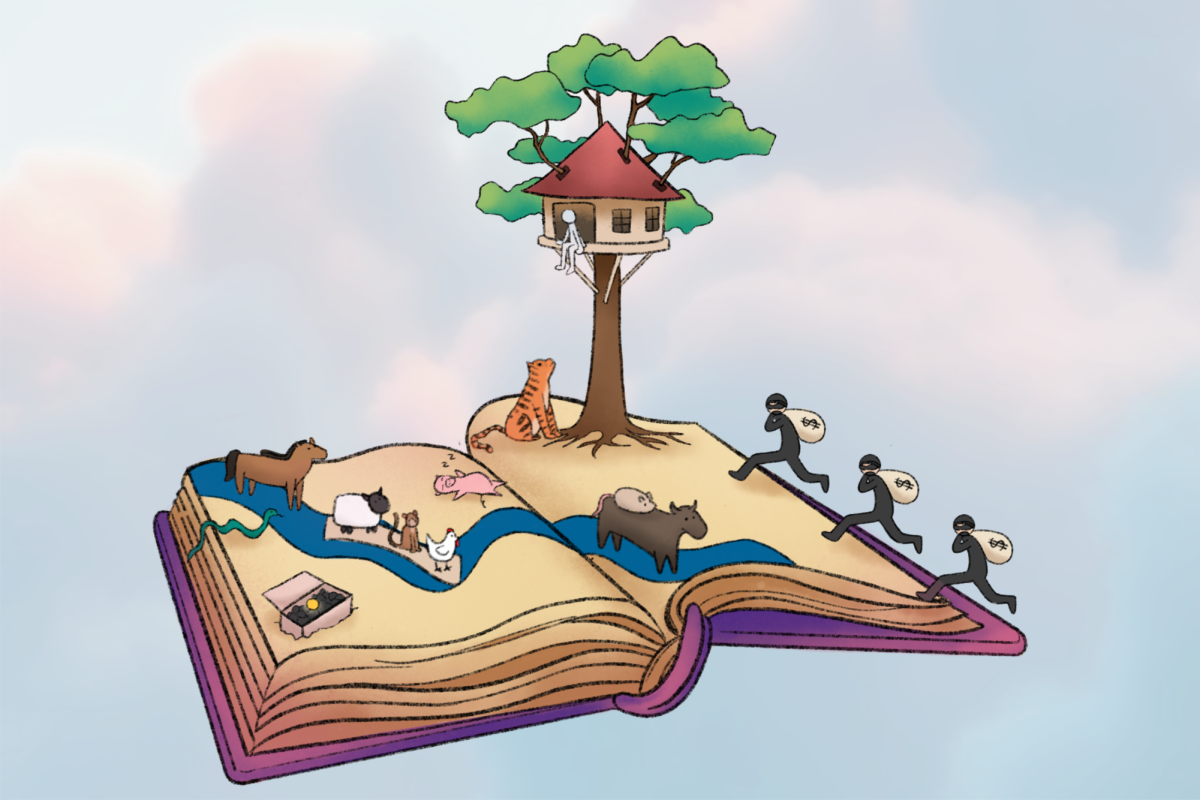Tucked in and curled up beneath the covers, a child eagerly awaits for their parent to sit down and begin telling a story. As time passes, these once cherished stories become less prominent, fading with the influx of new experiences in life. Yet, in periods of nostalgia, these fond memories resurface as something that brings fresh perspectives. Many of the stories told to young children are often simplified explanations of important life lessons intertwined with fun aspects to keep them engaged.
Good Person Bad Person
One such instance was a narration about the concept of karma told to junior Sanya Badhe when she was young, passed on through generations of her family.
There were two businessmen, Good Person and Bad Person, who were very good friends despite drastic differences in their work ethics. Good Person was always fair, consistently performing good deeds for others, while Bad Person was cheating people and taking advantage of them.
One day, they were hiking in a lush forest and the sun was starting to set. Good Person suddenly pricked his foot on a thorn on the ground, causing a small wound to form. Then, Bad Person suddenly stumbled across a box hidden beneath the undergrowth of the forest.
“He was surprised because there was a gold coin, with a lot of coal surrounding the singular coin,” Badhe said.
Bad Person began bragging to the Good Person, stating how he did so many good deeds, yet he wasn’t able to get a gold coin. They began discussing this odd occurrence and decided to ask a guru for more insight about the situation. The guru told them that this was due to their actions in a previous life. Good Person used to have horrible actions, and was sentenced to a hanging. Bad Person originally helped out a lot of people in need.
“Bad Person was supposed to get a box full of gold coins in this life,” Badhe said. “However, his actions in this life turned all but one of the gold coins into coal. Good Person had a lot of good deeds in his life, which helped reduce his punishment to merely a prick.”
This story was a way to teach Badhe about how karma works in life, especially how whatever actions one takes will always come back to them, even in a reduced version. It has enforced knowledge about different beliefs in her culture, even if Badhe doesn’t necessarily believe in them, she can still resonate with the message that it provides. Her family has also shared these stories with her to encourage her to grow up and become a better person, with these morals in mind.
“My brother and I used to sit in long car rides, and my mother would tell us these stories about karma,” Badhe said.
Ali Baba and the 40 Thieves
A folk tale that is commonly told is Ali Baba and the Forty Thieves, originally in Arabic, but translated to many other languages and slightly altered among different cultures. This version of the story that sophomore Abhigya Bandugula is familiar with opens up with Ali Baba working in the forest, where he suddenly overheard a group of 40 thieves who were heading to their treasure stash.
He was quickly able to determine how to enter the cave where the thieves stored their treasure. After waiting for the thieves to leave, he said the words “Open, Sesame!” and the cave opened. Ali Baba took a lot of gold and silver, and left the cave after closing the door by saying “Close, Sesame!”
Ali Baba brought these riches home, however, the thieves realized someone had stolen from their cave and set out to kill whoever had done so. While they were looking around, they discovered that one man, who once lived in poverty, was now in possession of incredible amounts of treasure.
“The thieves find and investigate Ali Baba,” Bandugula said. “Once they find his house, the thieves put a little ‘X’ on his door.”
Additionally, the thieves had kidnapped Ali Baba’s brother as revenge, killing him in the process. Ali Baba received this news and was devastated, and this act gave him a reason to kill the thieves. Thus, when the thieves snuck into his home in large oil pots, planning to ambush Ali Baba during a party he was hosting, Ali Baba conjured a plan for revenge.
“Ali Baba found out and told his servant to boil up a ton of oil,” Bandugula said. “He poured in the hot oil and the 40 thieves came out screaming and in pain. As the thieves were discovered, they were put into jail for life. In the end, even though Ali Baba is rich, his brother has passed, so he is left at a loss.”
Even with all the different variations of this story, there is still a common message that Ali Baba and the 40 Thieves shares: one should not bow down to greed. In this case, due to Ali Baba’s greed, he ended up losing his own brother.
“I associate this story with happy memories, especially the fuzzy feeling from when my dad is tucking me into sleep, since he would always tell this story,” Bandugula said.
The Chinese Zodiac
Childhood stories can also give explanation and background to certain phenomena or how certain aspects of one’s culture works. In Chinese culture, the calendar system includes 12 separate animals representing specific years in a 12-year cycle. In his early elementary school years, sophomore Cameron Chao was taught a folk tale about how this system was implemented.
Long ago, there was a competition announced to all the animals about a race that would determine a time measurement system for humans. In order to win, the animals must cross a large river to reach the other shore, which would secure them a position as a zodiac.
The first animals to finish the race were the rat and the ox. The rat couldn’t swim across the vast water body, so it asked for a ride from the ox, promising to give the ox first place in exchange.
“The ox agreed to carry the rat across,” Chao said. “But the rat was sly, and at the last minute, the rat jumped off the ox’s back and took first place.”
The tiger had also followed the rat and the ox, coming in third. The rabbit had been hopping from stone to stone, attempting to cross, but slipped. However, the rabbit was able to grab onto a log, floating to the finish line with a mysterious puff of air pushing it. The dragon, who could fly, hadn’t come in first like many had expected, as it was kind-hearted and had stopped to help multiple people along the way. The puff of air the rabbit had felt was from the dragon who had seen it struggling on the log, and the dragon ultimately came in fifth.
The horse galloped towards the finish line, but the snake suddenly appeared, scaring the horse and stealing sixth place. Still, the horse was able to grasp seventh place.
“Then, the sheep, monkey and the rooster came and decided to help each other,” Chao said. “They built a raft and all paddled across the river, finishing eighth, ninth and tenth.”
For the final couple of animals, they had been caught up in other activities before finally claiming their place. The dog, who was very good at swimming, ended up distracted and was playing along the shores until it finally remembered its goal. The pig had felt hungry along the race, and stopped to eat, falling asleep. Once the pig finally rose, it was able to finish, becoming the 12th and final animal in the zodiac.
“The story is important to Chinese culture and it affects the names of each year and how the zodiac system was formed,” Chao said. “The part where the sheep, monkey and rooster work together to paddle was also a cool moment; it represents a side of their personality well.”
The Man and the Tiger
Stories can also hold emotional significance, associated with the fun and comforting moments from the past. Senior Zayan Azom’s grandmother told him a story that fills this position.
There was once a man who met a hungry tiger. The man realized the danger and told the tiger that he couldn’t be eaten since he had a lot of cool things to teach it.
“Then the man made the tiger go on quests to fetch objects, specifically, things that would help the man avoid getting eaten,” Azom said. “An example was a stick to beat up the tiger.”
After performing these ridiculous quests, the tiger realized the man’s true intentions, which enraged the tiger. It decided to gather all of its friends and intrude the man’s home. However, they soon find out that the man lives in a tree house.
“So the tiger had to get a bunch of animals and had them stack onto each other to get up there,” Azom said. “The man then dropped a beehive on the tiger at the very bottom, causing all the animals to scatter away.”
The story had been passed down from generation to generation, each member of the family creating their own version to be told. When Azom had come home from school in a bad mood, his grandmother would tell him this story and the entertaining elements of it would cheer him up.
“I have a lot of positive memories associated with this story,” Azom said. “It was more than the story itself. I feel that because it created so many memories, it holds a special place in my life.”
These stories continue to be passed through generations, filling childhood memories with fantastical tales and moral lessons to be remembered. Sharing these memories gives insight into someone’s identity and provides a way to look back at those fond moments.













































































